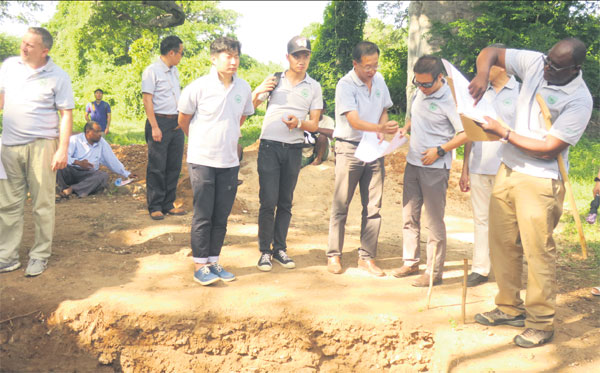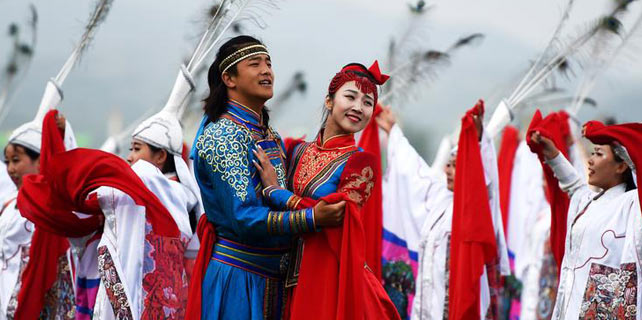Where Chinese history intersects with Africa
Young archaeologist looks for big picture in early connections between two continents
The old town of Lamu is unlike many towns in Kenya. While many urban centers are escaping the clutches of underdevelopment by embracing modern infrastructure, some areas of Lamu are trying to ward off the intrusion.
Lamu old town wants to retain the heritage and culture that carried it onto the list of UNESCO heritage sites.
About 350 kilometers north of Mombasa, Lamu was listed in 2001. It's famous for its tranquility, donkey-only transport system and abundance of fresh tropical fruit. Built using coral and mangrove timbers, the town, which is characterized by narrow streets, is the oldest and best-preserved example of Swahili settlement.
|
Yin Tianjie (with cap), an undergraduate at Sun Yat-sen University in Guangzhou, China, surreys a site on Manda Island with other archaeologists. Lucy Morangi / China Daily |
Diving into the humid coastal temperatures, Yin Tianjie - an archaeology undergraduate at Sun Yat-sen University in the Chinese city of Guangzhou, Guangdong province - arrived on Manda Island to join an excavation project led by Chapuruka Kusimba.
There were five other students involved in the project that spanned three months. In addition to Yin, there were two Chinese, one Kenyan and two American students, the latter having arrived earlier. The project, which has now been completed, involved seven years of China-Kenya joint research. It was supported by the National Museums of Kenya and Sun Yat-sen University.
"I arrived on July 3. We were looking at the impact of ancient relations between China and East Africa," the ebullient researcher says.
China's growing influence in Africa today has reignited a debate on the history of relationships in the premodern Indian Ocean, Yin says, noting that China has developed initiatives such as the Forum on China-Africa Cooperation and the Belt and Road Initiative - involving not only the continent but the larger global community.
"This is an interesting field for study at the moment, coming at a time China and other emerging economies are facing a difficult global landscape due to protectionism," he says.
The project has unearthed invaluable artifacts, including Chinese stoneware and a coin believed to have been carried by master mariner Zheng He - among other things. This, according to Yin, points to healthy interactions between Chinese and Africans from as early as the 15th century.
He is well aware of some huge archaeological projects going on back home.
"It's similar to my hometown in Chengdu, where archaeological projects are looking into the tombs during the Han period," he says, "But this is different, since we are not only looking at graves but also settlements and how people adapted."
Yin was part of the excavation team that unearthed residences built on top of each other over time. The ruins date to the Tang Dynasty (618-907) and point to an advanced civilization from about 200 to 1430 AD. It was abandoned and never inhabited.
This discovery has pricked the interest of the Chinese student.
"Studies that focus on the tombs miss the big picture of how people lived and what formed their habits. But when you look at a household, you see life, aspirations and adaptations to changing environments," Yin says.
Senior researcher Chapuruka Kusimba says the field research, though brief, has enabled students to participate in the process of creating knowledge and bearing witness to how knowledge is unraveled.
The process builds character, the senior researcher says.
"Research requires patience, honesty, and fortitude. It is dirty but fun. The process of building knowledge requires individuals who are committed to seeking the truth in all its dimensions. Fame should never be the goal of research, but unveiling knowledge about past experiences is one of the best ways of making a living," he says.
The archaeologists are calling for more robust cooperation with China, with particular focus on capacity building, exchanges and joint research programs. Incorporating young researchers is also an urgent need as interest in archaeology is seemingly waning in the younger generation.
"I learned a great deal about how the Chinese academy operates. I hope to continue to involve students in future research but will want students who have taken courses in African history, language and anthropology - to prepare them better," Kusimba says.
Yin says the process has given him access to ancient Chinese trading activities that he can link to current developments.
"It not only explains contemporary bilateral relationships but offers a common platform on which young Chinese and Africans can build and sustain bridges," he says, adding that the experience was invaluable and changed his views of Africa.
He intends to pursue his interest in Africa, specifically through masks.
"I was studying some masks around East Africa, and I think this is an area I will pursue once I go back to China," he says. "And I will continue to collaborate with the professors I have met here."
lucymorangi@chinadaily.com.cn





















